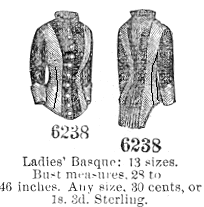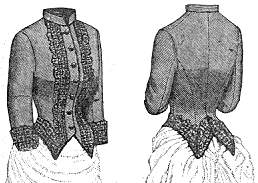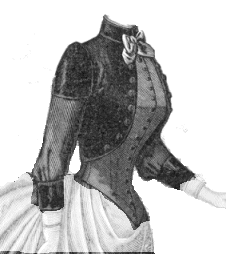![]()
Pattern Making- The Late Bustle Era Bodice
![]() The Look of the 1880's
The Look of the 1880's ![]()
I don't like to say always or never when researching clothing, but as a general rule we
are looking for a good representation of the general population or
in other words the average person. Below are some observations about the late bustle era.
![]() What is the look of the 1880's?
What is the look of the 1880's?
- Tightly fitted bodice- with 4 main pattern parts- Front, underarm, side forms, and back
- shoulder seam sloping to the back
- Tightly fitted sleeve- similar to the modern man's coat sleeve, cut in two pieces: an
upper and under sleeve- Generally no shoulder fullness (there are a few exceptions to this and these are generally
worn by younger women).
- Bodice waistline is at natural waistline
- Collar usually a stand-up for social wear, sometimes rolled for more casual.
- Neckline only low for evening or dress wear.
- Sleeves 3/4 length (below elbows) or longer with or without wide decorative cuffs.(the
exception being evening wear)
- Often bodice extends in a continuous piece below the waist line- this extension may be
several shapes and can be even length all the way around or shaped higher at the hip and/or back
Line drawings of basic shapes of the era are found in your text on pages 6-8.
Breaking the shape down a bit more for the late bustle period
1876-1881
Very long bodice lines often extending to the bottom of the hip. The bustle is usually low and the bodice is most often cut with slope from the hip to waist to allow for this fullness. During this period bodices are very tightly fitted and may have an extra underarm or sideback piece. Also the side back may extend to the shoulder seam instead of rounding to the armhole. Contrasting overlay often used as decoration center front and back to accentuate the long slim look. Sleeves are slender and shoulder line (armscye) can be anywhere from the natural level to the edge of the shoulder. Cuff decoration is usually very wide and often elaborate. Collars are usually one half to one inch tall, often military style with a ruffle peeping out from beneath. Princess line dresses very popular (continuous line from shoulder to hem with no waist seam)
Ladies Basque from 1879 Butterick Pattern Catalog

For a bit more information on this era see your textbook p. 17-18
1881-1884
The bustle has returned to normal height and is moderately full. This allows the basque of this period great variation. It is most often closed center front, with a stand up collar that is becoming increasingly taller. Bodice hem is generally shorter than previously common and often shaped. Back hip can be flared or pleated to allow for bustle. Cuffs, when used, are generally of moderate width. Shorter sleeves are seen for day wear one length being about an inch above the wristbone.
For a bit more information on this era see your textbook p. 19-20
1883 Demorest
Alymar Basque Pattern
1884-1888
Very full bustle of this era lends itself to bodices that are often shorter or set in full pleats at the back. The most common fronts bottom finish is a single point center front or "vest front" points. The most popular bodice decorations are a vest front contrast, buttoned on panel, or contrasting revers or lapels. Cuffs are usually narrow or non-existent, although use of buttons or braid decorations is also seen. Collars are at least 1" tall.
Basque Pattern
1886 Butterick Pattern Catalog
For a bit more information on this era see your textbook p. 19-20
1887-1889
Asymmetrical decorations popular on bodices, seen in side front closings, fabric drapings from one side to the other, etc. Vest fronts and bolero jacket trimmings also popular. Sleeves are starting to be gathered at sleeve head- known as "high sleeves"
Collars are also getting taller, covering most of the throat.
For a bit more information on this era see your textbook p. 21

Bodice from 1888
Harper's Bazar
Some more "generalized" rules - Major fashion deviations are generally worn by the young or the rich.
- Waists and blouses are worn for "undress" or at home by unmarried girls. (Women who needed working dresses generally opted for wrappers)
- Lace was used sparingly for the average woman.
If you would like to know more about what was "in" year by year- you might look
up the book "English Women's Costume in the 19th Century" by C. Willet Cunnington. The chapters are divided
by decade and each year has fashion descriptions for all day, evening and sporting wear. American fashion, as a
general rule during the 19th century, followed English fashion quite closely, so it is a very good guide. (It was
a bit more conservative than French styles) Remember also that even "out west", styles were not that
far behind during this era. It would be very unlikely that a lady had no access to a fairly recent (within 1-3yrs)
pattern, whether it had been copied from a neighbor, friend or relative or purchased mail order or bought at the
local drygoods store. If your dress was of an unfashionable style- you simply took it apart and "remade"
it.
![]() To be able to Make the bodice of the Late bustle era you need to know when and what you
are trying to accomplish. Attempting to familiarize yourself with the era should be your next step. We will first
look at extant garments(existing garments from the period), then fashion plates/and patterns and finally photographs
to attempt to understand the differences between idealized fashion and reality of most women's wardrobes.
To be able to Make the bodice of the Late bustle era you need to know when and what you
are trying to accomplish. Attempting to familiarize yourself with the era should be your next step. We will first
look at extant garments(existing garments from the period), then fashion plates/and patterns and finally photographs
to attempt to understand the differences between idealized fashion and reality of most women's wardrobes.
Lesson 1-Page 4
Lesson Index
Page 1- 2 - 3 - 4 - 5 - 6 - 7 - 8 - 9
Copyright 2001 by Marna Jean Davis. All contents of the websites associated
with the lessons of Marna Jean Davis and Shooting Star Enterprises are protected by U.S. copyright laws. They may
be printed out by registered students for their own personal use but may not be reprinted in any other manner or
reproduced in any form.
Costume Classroom is a division of The Costume Gallery, copyright 1997-2001.
Having problems with this webpage contact: questions@costumeclassroom.com